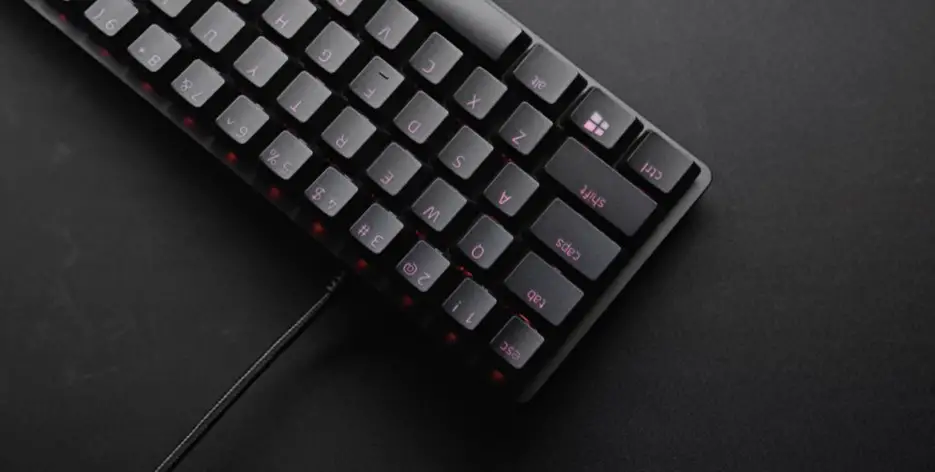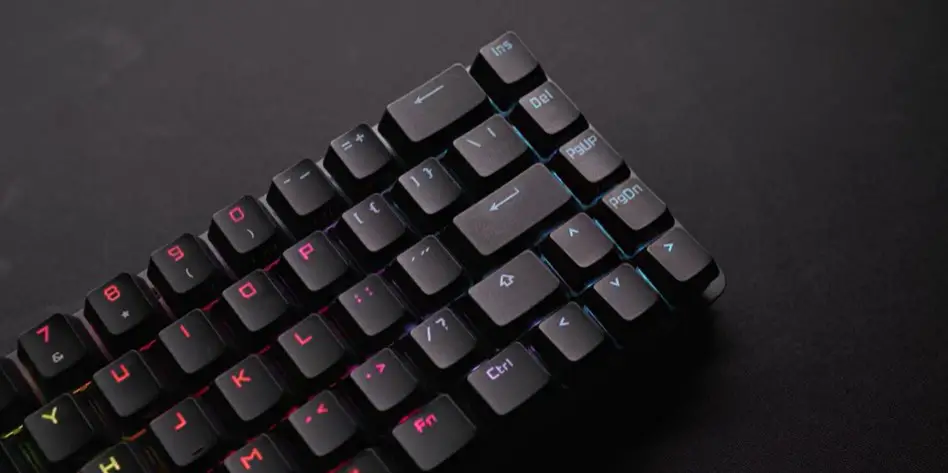If you’re using a 60% keyboard and need the “Insert” key, you may be scratching your head trying to figure out where to insert the key on a 60% keyboard. Unlike traditional keyboards with a dedicated “Insert” key, 60% often sacrifice some keys to create a more compact design.
In this blog post, we’ll show you exactly where to find the “Insert” key on a 60% keyboard and how to access its functionality. Whether you’re a gamer looking for that extra edge or a writer who relies on keyboard shortcuts, this information will come in handy. So let’s dive in and uncover the mystery of the missing “Insert” key.

What Is The Insert Key Do on A 60% Keyboard?
Most of the time, the Insert key switches between the two ways to type text: overtype mode and insert mode.
In overtype mode, the letters you type will replace any already there. So, you’ll be writing on top of your written text. In the insert mode, on the other hand, you type the characters where they already are, and the ones that are already on the page move to the right.
It’s important to know that the insert/overtype mode switch isn’t meant for your PC as a whole or even a single program. When you press the Insert key, the mode changes only for the window you are currently working in. In many modern programs, the usual mode is set to insert. Still, by pressing the Insert key, the user can switch to the overtype mode.
The Insert key function can be used in many different ways. Still, having the Insert key on your PC when you don’t need it can be unpleasant. For example, if you accidentally press the Insert key, the overtype mode will be turned on, and the text you are typing will be replaced.
Where Is The Insert Key On A 60% Keyboard?
Because of the compact design of the 60% keyboard, there is no Insert key. This means you must use a combination of keys or a specific key binding to access the Insert function.
When Num Lock is disabled, the 0 on the number pad in the top right corner of your keyboard will act as an insert key. That’s why the key reads “0” and “Ins.” Some common locations for the Insert key on a 60% keyboard include being mapped to the Fn key and another key, such as the Delete or Backspace key.
It’s essential to consult the user manual or documentation for your specific keyboard model to determine the exact location and method for accessing the Insert function.
How To Use The Insert Key Function If It’s Not On Your Keyboard?

Using the Numpad Keys
You can use the Numpad on your keyboard to push the Insert key. Numpad keys also function as cursor control keys. With Num Lock enabled, the number keys will function similarly. If Num Lock is disabled, they will function as Cursor Control keys. When Num Lock is turned on, but Shift is pressed, the system briefly releases Shift and acts as if Num Lock were turned on. Make sure your Num Lock is off before you begin.
- Turn the NumLock off.
Now, at the bottom of the Numpad, press the 0 key. The Numpad-0 key will replace the Insert key.
- Numpad-0 is used as the Insert key.
When the Num Lock is turned on, you can also utilize the Shift key as a temporary toggle. Shift + Numpad-0 will function as an Insert key when Num Lock is enabled.
Using the Windows On-Screen Keyboard
Using the On-Screen keyboard, you can get around problems with your computer keys. The Microsoft working system comes with a software-based keyboard. You can use the joystick, the mouse, or a touchscreen to type words on the On-Screen Keyboard. It will have all the keys that should be on a computer. On the On-Screen keyboard, it is easy to find the Insert key.
- Use the Windows search tool to look for the On-Screen Keyboard. You can open the On-Screen Keyboard by clicking on it.
- Now you can choose the window or place to use the Insert key. Then, move the mouse over the Insert key on the On-Screen Keyboard and click on it.
- You can also use the Options button to change how the On-Screen Keyboard works.
Remapping the Insert Key through AutoHotkey
With the AutoHotkey app, you can change what the Insert key does. If you don’t have the Insert key or it doesn’t work right, you can change it to any other key or set of keys. But make sure you use a key combination that still needs to be used. Some of the apps have key combos you might not know about. In the steps below, we use the key combination as an example. You can use your key combination to bind the Insert key:
- Open your computer and go to the site for AutoHotkey. Click the Download button and then the Download Current Version button. You can launch the app by following the steps in the installation guide.
- After installing the AutoHotkey app, you can launch it or search for it using the Windows search tool to look at the tutorials and other information.
- To use Hotkey, right-click on the Desktop and choose New > AutoHotkey Script from the menu. Name and save the new script.
- Right-click on the Script file and select “Edit Script” from the menu that appears.
- It will start a Notepad, and then you can press the Hotkey for Insert to add a new line.
- You’ll need to run this hotkey script if you want to use that key combination as the Insert key.
Where is the Insert key on Apple keyboards?
The Insert key is renamed the Fn key on Apple computers, laptops (MacBooks), and keyboards. On an Apple Mac, pressing Fn+Enter is shorthand for the Insert key.
Where is the Insert key on a PC laptop keyboard?
On a laptop, the Insert key is part of another key that goes around the Backspace key. When you want to use the second key on a laptop, you must press the Fn key.
How to Disable the Insert Key on Windows 10?
If you don’t want to delete your work accidentally, you can turn off the Insert key. Here is how to do it on a computer with Windows 10.
Using the Registry Editor, you can turn off the Insert key. This is how:
- Press the Window key on your computer.
- Type “registry editor” (no quotes).
- When you press Enter, the box for the Registry Editor will appear.
- Find the “HKEY_LOCAL_MACHINE” folder on the left side of the Registry Editor window and double-click it.
- Double-click the SYSTEM folder to open it.
- Open the folder for the CurrentControlSet.
- Find the area called “Control,” and then double-click it.
- Open the file called “Keyboard Layout.”
- Once you are in the folder, right-click the right side of the window and choose “New” > “Binary Value.” Give it any name you want, like “Insert_Disable.”
- Click twice on the file called “Insert_Disable.”
- Paste the following text into the Value data window:
- 00 00 00 00 00 00 00 00 02 00 00 00 00 00 52 E0 00 00 00 00
- Hit the “OK” button.
- Now you can close the Registry Editor and turn on your machine again.
- After you restart your computer, you won’t be able to use the Insert key.
- Using the Registry Tool, you can also turn off the Insert key. This is how:
- Go to the browser you always use.
- Paste the link https://www.howtogeek.com/wp-content/uploads/2020/04/DisableInsertKey.zip into the address bar.
- Hit the Enter button on your computer.
- Choose the DisableInsertKey.zip file and open it.
- Then, double-click on the file called DisableInsertKey.reg.
- Whenever asked, click Yes.
- Restart your PC
So, now the Insert key should no longer work on your PC. You can also use some third-party apps to turn off the Insert key. Just quickly search on Google for the tool you need, and you should find many free tools that will help you fix the problem.
Final Words
Finding the “Insert” key on a 60% keyboard can be confusing, mainly if you’re used to traditional keyboards with dedicated keys. However, with some guidance, you can easily access the functionality of the “Insert” key on your compact keyboard.
By following the steps outlined in this blog post, you can locate and use the “Insert” key on your 60% keyboard, whether you’re a gamer seeking an advantage or a writer relying on keyboard shortcuts. So don’t let the smaller size of your keyboard hold you back – unlock its full potential by finding and utilizing the “Insert” key.

I am a regular user of computer keyboards. For using keyboard face different kinds of problems and also solve it very easily. I love sharing knowledge about keyboards.
